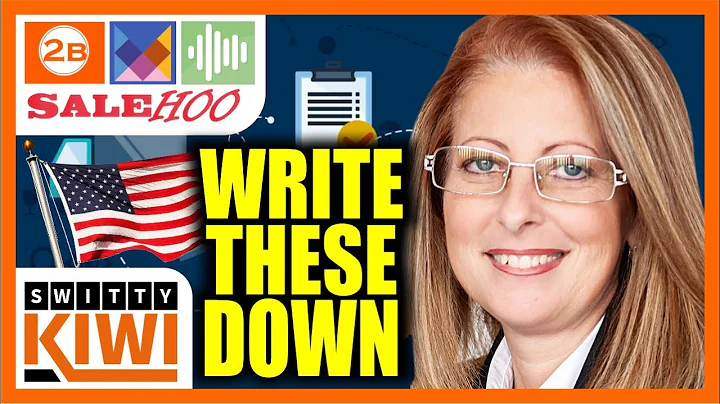Walmart Dropshipping 101: A Beginner's Guide
Table of Contents
- Introduction
- Choosing the Right Type of Walmart Store
- Traditional Drop Shipping
- Two-Step Drop Shipping
- WFS Store (Walmart Fulfillment Services)
- Hybrid Store
- Pros and Cons of Different Store Types
- Acquiring a Walmart Store
- Doing it Yourself
- Hiring Someone
- Buying One Outright
- Sourcing for Your Store
- Learning it Yourself
- Hiring a Team
- Repricing Techniques
- Manual Repricing
- Repricing Software
- Fulfillment Considerations
- Using Multiple Suppliers
- Adapting to Platform Changes
- Management and Compliance Tasks
- Customer Service
- Returns and Reimbursements
- Tracking Issues
- Supplier Management
- Business Evolution
- Conclusion
Starting a Walmart Store: A Comprehensive Guide for Beginners
Are you interested in starting a Walmart store but don't know where to begin? In this comprehensive guide, we will take you through the process step by step, covering all the considerations and decisions you need to make before diving into the world of Walmart drop shipping. Whether you're a beginner or already have some experience in e-commerce, this guide will provide you with valuable insights and tips to ensure your success.
1. Introduction
Walmart is currently one of the most profitable platforms for drop shipping. With the right strategies and a commitment to proper management, you can build a lucrative business. However, before you embark on this journey, it's crucial to understand the different types of Walmart stores and choose the one that aligns with your goals and resources.
2. Choosing the Right Type of Walmart Store
There are four main types of Walmart stores: traditional drop shipping, two-step drop shipping, WFS store (Walmart Fulfillment Services), and hybrid store. Each has its own pros and cons, so it's essential to evaluate them carefully and select the one that suits your needs.
Traditional Drop Shipping
Traditional drop shipping involves sourcing products from suppliers and having them shipped directly to your customers. However, this type of store can lead to getting banned or suspended if not done correctly. Therefore, it's not advisable to rely solely on traditional drop shipping for your Walmart store.
Two-Step Drop Shipping
Two-step drop shipping requires an additional step where a third-party picks up the package from the supplier and then sends it to your customers. This method often incurs higher shipping costs and may result in lower profit margins.
WFS Store (Walmart Fulfillment Services)
A WFS store is similar to Amazon's FBA (Fulfillment by Amazon) service. Walmart handles all the fulfillment, including storage, packaging, and shipping. While this option can alleviate some of the burdens of fulfillment, it may limit your flexibility and control over the process.
Hybrid Store
A hybrid store combines elements of traditional drop shipping, two-step drop shipping, and WFS. It offers the best of all worlds, allowing you to maximize profits while maintaining compliance with Walmart's policies. This type of store is ideal for those who want to minimize the risk of suspension and enjoy the benefits of various fulfillment methods.
3. Pros and Cons of Different Store Types
Before making a decision, it's essential to weigh the pros and cons of each store type. The factors that influence your choice include the time you can dedicate to the store, the budget you're willing to allocate for its setup and maintenance, and your long-term goals. While a fully automated hybrid store might save you time and effort, it comes with a higher price tag. On the other hand, building and managing a store yourself requires a significant investment of time and a learning curve.
4. Acquiring a Walmart Store
Once you've decided on the type of store you want, the next step is to acquire it. There are three main ways to do this: doing it yourself, hiring someone, or buying one outright.
Doing it Yourself
If you choose to create the store yourself, you'll need to gather the necessary information, such as setting up an LLC, obtaining an EIN (Employer Identification Number), and developing a website. While this option allows for complete control over the process, there is a learning curve, and success is not guaranteed.
Hiring Someone
If you're not comfortable handling the setup yourself, you can hire an expert to apply for the store on your behalf. There are many professionals available who specialize in setting up Walmart stores. However, hiring someone may incur additional costs.
Buying One Outright
For those who prefer a more streamlined approach, buying an established store outright is an option. This eliminates the need for setup and allows you to start selling immediately. However, acquiring a pre-existing store can be expensive, with prices ranging from $8,000 to $10,000.
5. Sourcing for Your Store
Once you have your store set up, the next challenge is sourcing products. This involves finding reliable suppliers who can provide high-quality products at competitive prices. You have two options for sourcing: learning it yourself or hiring a team to handle it for you.
Learning it Yourself
Learning the sourcing process yourself can be time-consuming and may require paying for courses or resources to gain the necessary knowledge. However, acquiring this skill can be valuable in the long run as you can use it for future ventures or even offer consulting services to others.
Hiring a Team
If you prefer to focus on other aspects of your business and leave the sourcing to experts, you can hire a team to handle this task. Platforms like Upwork provide access to freelancers with experience in product sourcing. However, finding the right team may require trial and error.
6. Repricing Techniques
To remain competitive in the Walmart marketplace, you need to ensure your prices align with those of your competitors. Repricing can be done manually or with the help of specialized software. Manual repricing involves periodically checking and adjusting your prices based on market conditions. Alternatively, you can invest in repricing software that automates this process for you.
7. Fulfillment Considerations
Efficient fulfillment is vital for maintaining customer satisfaction and building a successful Walmart store. Apart from managing a reliable team, there are a few additional aspects to consider.
Using Multiple Suppliers
Relying on a single supplier can be risky, especially if they face issues or suspensions. To mitigate this risk, consider working with multiple suppliers. This ensures you have alternative sources for your products and avoids disruption to your fulfillment process.
Adapting to Platform Changes
Platforms like Amazon may periodically change their policies or suspend certain accounts. It's crucial to stay informed and adapt your sourcing and fulfillment methods accordingly. This may involve finding alternative ways to source products or utilizing third-party tracking apps for better order management.
8. Management and Compliance Tasks
Running a successful Walmart store requires ongoing management and compliance with Walmart's rules and regulations. These tasks include handling customer service, managing returns, resolving tracking issues, and keeping up with supplier changes. It's important to stay organized and responsive to ensure a positive customer experience.
9. Conclusion
Starting a Walmart store can be a profitable venture if you approach it with the right knowledge and strategies. Consider the different types of stores, weigh the pros and cons, and select the one that aligns with your goals and resources. Acquiring and sourcing for your store requires careful decision-making, and proper management and compliance are crucial for long-term success. With dedication and the right approach, you can build a thriving Walmart store that generates consistent revenue.
Highlights
- Walmart drop shipping offers high profitability if managed properly.
- Different types of Walmart stores include traditional, two-step, WFS, and hybrid stores.
- Hybrid stores, combining various fulfillment methods, are considered the best option.
- Acquiring a store can be done by yourself, hiring someone, or buying one outright.
- Sourcing options include learning it yourself or hiring a team of experts.
- Repricing techniques ensure competitive pricing in the Walmart marketplace.
- Efficient fulfillment involves using multiple suppliers and adapting to platform changes.
- Management and compliance tasks include customer service, returns, and supplier management.
- Walmart drop shipping requires ongoing commitment and adaptability for long-term success.
FAQ
Q: Is drop shipping allowed on Walmart?
A: Yes, drop shipping is allowed on Walmart, but it requires careful management and adherence to Walmart's policies.
Q: Can I have multiple suppliers for my Walmart store?
A: Yes, using multiple suppliers is recommended to avoid disruptions to your fulfillment process.
Q: Can I source products myself for my Walmart store?
A: Yes, you can learn the sourcing process yourself or hire a team to handle it for you.
Q: How often should I reprice my products?
A: Repricing should be done periodically to ensure competitiveness in the Walmart marketplace.
Q: What challenges should I expect in managing a Walmart store?
A: Challenges include customer service, returns, tracking issues, and adapting to platform changes.
Q: Is it possible to automate a Walmart store?
A: Yes, fully automated options are available, but they come at a higher cost.



















